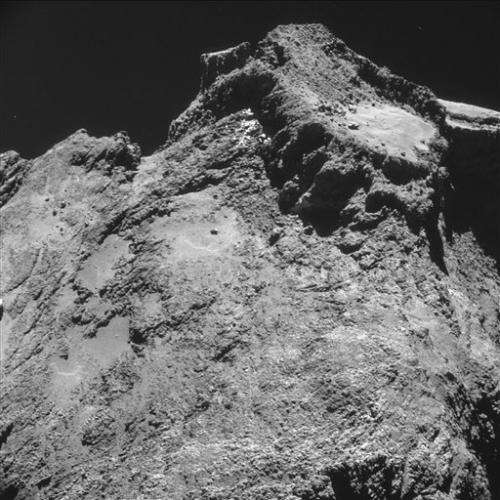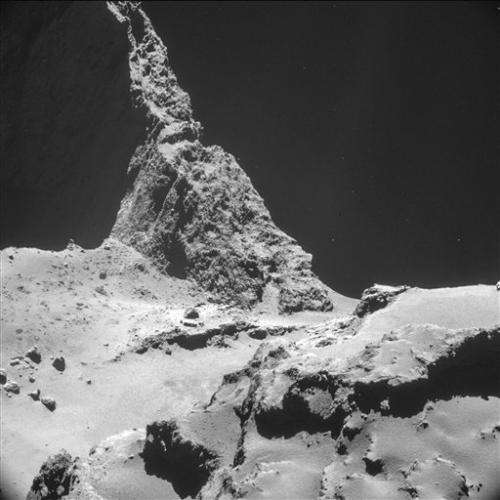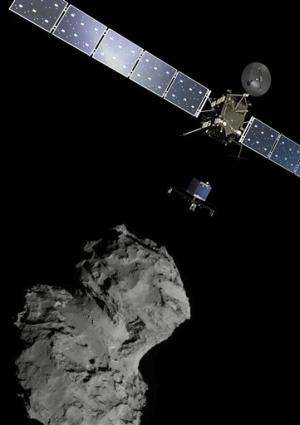Rosetta begins descending to comet 67P (WATCH LIVE)

Hundreds of millions of miles from Earth, a speeding European spacecraft released a lander toward the icy, dusty surface of a comet on Wednesday, setting off a seven-hour countdown to an audacious attempt to answer some of the biggest questions about the origin of the universe.
A landing would cap a 6.4 billion-kilometer (4 billion-mile) journey by the European Space Agency's Rosetta spacecraft, launched a decade ago to study the 4-kilometer-wide (2.5-mile-wide) 67P/Churyumov-Gerasimenko comet. If successful, the Philae lander would be the first spacecraft to land on a comet.
Relief as signal arrives from comet lander
"It's on its own now," said Stephan Ulamec, Philae Lander Manager at the DLR German Aerospace Center.
Due to the vast distances involved and the time delays in receiving data, confirmation of a landing should reach Earth about 1603 GMT (11:03 a.m. EST).
Mission controllers clapped and embraced at mission control in Darmstadt as they got confirmation that the unmanned Rosetta, speeding through space in tandem with the comet at 41,000 mph (66,000 kph), had successfully released the 220-pound (100-kilogram), washing machine-sized Philae lander.
"Philae has gone. It's on its path down to the comet," Rosetta flight director Andrea Accomazzo said. "We are all glad that it worked flawlessly in the past minutes."
Philae was supposed to drift down to the comet and latch on using harpoons and ice screws. ESA announced hours before the release that a third component—an active descent system that uses thrust to prevent the craft from bouncing off the surface of the low-gravity comet—could not be activated. It wasn't clear how big of a setback that was.

"We'll need some luck not to land on a boulder or a steep slope," Ulamec said.
During the descent, scientists are powerless to do anything but watch, because the vast distance to Earth—500 million kilometers (311 million miles)—makes it impossible to send instructions in real time. It takes more than 28 minutes for a command to reach Rosetta.
About two hours after the separation from Rosetta was confirmed, scientists re-established contact with the lander.
"Now we can follow it on its descent," said Paolo Ferri, head of mission operations at ESA.
Rosetta, which was launched in 2004, had to slingshot three times around Earth and once around Mars before it could work up enough speed to chase down the comet, which it reached in August. Rosetta and the comet have been traveling in tandem since then.
If the lander's mission is successful, Rosetta and Philae plan to accompany the comet as it hurtles toward the sun and becomes increasingly active in the rising temperatures. Using 21 different instruments, the twin spacecraft will collect data that scientists hope will help explain the origins of comets and other celestial bodies.
The European Space Agency says even if Philae's landing doesn't succeed, the 1.3 billion-euro ($1.6 billion) mission won't be a failure. Rosetta will be able to perform about 80 percent of the scientific mission on its own.

A timeline of comet probe's 10-year journey
Europe's unmanned space probe Rosetta on Wednesday released a lander toward comet 67P/Churyumov-Gerasimenko. If successful, it will be the first time that a spacecraft has landed on a comet.
The audacious landing attempt is the climax of a decade-long mission to link up with the giant ball of dust and ice.
Here's a look at key moments during Rosetta's incredible trip:
___
March 2, 2004: Europe's unmanned probe Rosetta takes off from Kourou, French Guiana, after a series of delays, including an abandoned January 2003 launch window because of a rocket problem.
Feb. 25, 2007: Rosetta carries out a close flyby of Mars. European Space Agency's mission control breaks out in applause after the end of 15 tense minutes of radio silence as the craft passes behind the Red Planet.
Sept. 5, 2008: Probe successfully passes close to an asteroid 250 million miles from Earth. The spacecraft loses its radio signal for 90 minutes as planned during the flyby of the Steins asteroid, also known as Asteroid 2867.
July 10, 2010: Between Mars and Jupiter, Rosetta transmits its first pictures from the largest asteroid ever visited by a satellite after it flies by Lutetia as close as 1,900 miles (3,200 kilometers). It is the closest look to date at the Lutetia asteroid.
Jan. 20, 2014: Waking after almost three years of hibernation, Rosetta sends its first signal back to Earth. Systems had been powered down in 2011 to conserve energy, leaving scientists in the dark for 31 months.
Aug. 6, 2014: Rosetta swings alongside comet 67P/Churyumov-Gerasimenko somewhere between the orbits of Mars and Jupiter.
Nov. 12, 2014: The probe releases the Philae lander toward the comet's surface.
More information: All systems go for historic comet landing: phys.org/news/2014-11-comet-esa.html
Webcast of comet landing: new.livestream.com/ESA/cometlanding
© 2014 The Associated Press. All rights reserved.





















